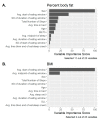Later Meal and Sleep Timing Predicts Higher Percent Body Fat
- PMID: 33383648
- PMCID: PMC7823810
- DOI: 10.3390/nu13010073
Later Meal and Sleep Timing Predicts Higher Percent Body Fat
Abstract
Accumulating evidence suggests that later timing of energy intake (EI) is associated with increased risk of obesity. In this study, 83 individuals with overweight and obesity underwent assessment of a 7-day period of data collection, including measures of body weight and body composition (DXA) and 24-h measures of EI (photographic food records), sleep (actigraphy), and physical activity (PA, activity monitors) for 7 days. Relationships between body mass index (BMI) and percent body fat (DXA) with meal timing, sleep, and PA were examined. For every 1 h later start of eating, there was a 1.25 (95% CI: 0.60, 1.91) unit increase in percent body fat (False Discovery Rate (FDR) adjusted p value = 0.010). For every 1 h later midpoint of the eating window, there was a 1.35 (95% CI: 0.51, 2.19) unit increase in percent body fat (FDR p value = 0.029). For every 1 h increase in the end of the sleep period, there was a 1.64 (95% CI: 0.56, 2.72) unit increase in percent body fat (FDR p value = 0.044). Later meal and sleep timing were also associated with lower PA levels. In summary, later timing of EI and sleep are associated with higher body fat and lower levels of PA in people with overweight and obesity.
Keywords: meal timing; sleep timing; time-restricted eating.
Conflict of interest statement
The authors declare no conflict of interest. The funders had no role in the design of the study; in the collection, analyses, or interpretation of data; in the writing of the manuscript, or in the decision to publish the results.
Figures




Similar articles
-
Cross-sectional associations of actigraphy-assessed sleep with dietary outcomes in emerging adults.Eur J Clin Nutr. 2024 May;78(5):420-426. doi: 10.1038/s41430-024-01417-9. Epub 2024 Feb 24. Eur J Clin Nutr. 2024. PMID: 38402354
-
The roles of sleep and eating patterns in adiposity gain among preschool-aged children.Am J Clin Nutr. 2022 Nov;116(5):1334-1342. doi: 10.1093/ajcn/nqac197. Epub 2023 Feb 10. Am J Clin Nutr. 2022. PMID: 35833269 Free PMC article.
-
Circadian timing and alignment in healthy adults: associations with BMI, body fat, caloric intake and physical activity.Int J Obes (Lond). 2017 Feb;41(2):203-209. doi: 10.1038/ijo.2016.194. Epub 2016 Oct 31. Int J Obes (Lond). 2017. PMID: 27795550 Free PMC article.
-
[Simple obesity in children. A study on the role of nutritional factors].Med Wieku Rozwoj. 2006 Jan-Mar;10(1):3-191. Med Wieku Rozwoj. 2006. PMID: 16733288 Review. Polish.
-
Examining the Role of Exercise Timing in Weight Management: A Review.Int J Sports Med. 2021 Oct;42(11):967-978. doi: 10.1055/a-1485-1293. Epub 2021 May 25. Int J Sports Med. 2021. PMID: 34034354 Free PMC article. Review.
Cited by
-
The mediating effect of DNA methylation in the association between maternal sleep during pregnancy and offspring adiposity status: a prospective cohort study.Clin Epigenetics. 2022 May 20;14(1):66. doi: 10.1186/s13148-022-01284-w. Clin Epigenetics. 2022. PMID: 35596190 Free PMC article.
-
Cross-sectional associations of actigraphy-assessed sleep with dietary outcomes in emerging adults.Eur J Clin Nutr. 2024 May;78(5):420-426. doi: 10.1038/s41430-024-01417-9. Epub 2024 Feb 24. Eur J Clin Nutr. 2024. PMID: 38402354
-
Late bedtime was associated with increased androgen and reduced lean mass in women with polycystic ovary syndrome: a cross-sectional study.J Ovarian Res. 2025 Jul 11;18(1):148. doi: 10.1186/s13048-025-01730-2. J Ovarian Res. 2025. PMID: 40646572 Free PMC article.
-
Early time-restricted eating compared with daily caloric restriction: A randomized trial in adults with obesity.Obesity (Silver Spring). 2022 May;30(5):1027-1038. doi: 10.1002/oby.23420. Obesity (Silver Spring). 2022. PMID: 35470974 Free PMC article. Clinical Trial.
-
Early or Delayed Onset of Food Intake in Time-Restricted Eating: Associations with Markers of Obesity in a Secondary Analysis of Two Pilot Studies.Int J Environ Res Public Health. 2021 Sep 21;18(18):9935. doi: 10.3390/ijerph18189935. Int J Environ Res Public Health. 2021. PMID: 34574859 Free PMC article.
References
MeSH terms
Grants and funding
LinkOut - more resources
Full Text Sources

